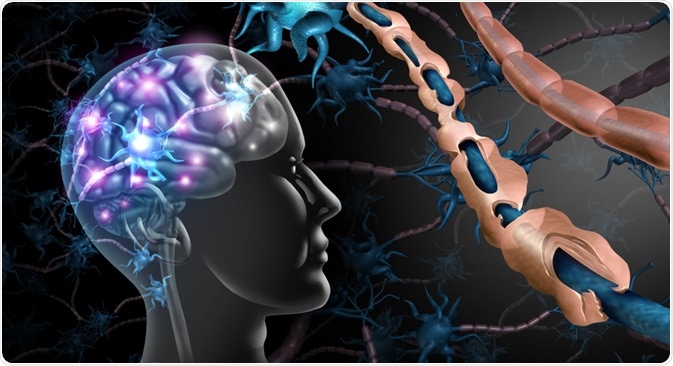Getting an early diagnosis for multiple sclerosis (MS) is important in ensuring better long-term outcomes and quality of life. The challenge, however, is that getting an early diagnosis for MS is challenging and diagnoses are currently made in advanced disease stages.

Multiple Sclerosis. Image Credit: Lightspring/Shutterstock.com
Current Diagnosis of MS
MS varies considerably between patients depending on the type and the parts of the body affected. Many of the symptoms of MS can also be associated with other disorders often complicating diagnoses. However, some of the most common symptoms include fatigue, pain, problems with walking or holding items, numbness or tingling in various parts of the body, problems with vision, issues with balance and coordination, bladder/bowel/sexual problems as well as some degree of cognitive disturbances.
The most common type of MS (around 80% of all cases) is relapse remitting MS in which there are episodes of existing or new symptoms which worsen over days or weeks/months (relapse) and episodes of slow recovery over time (remitting). However, as the disease progresses over many years, the condition becomes progressively worse (secondary progressive MS). Around 10% of all cases are primary progressive MS cases where symptoms gradually become worse from onset without any remission.
The issue with current diagnostic techniques is that many of the earliest symptoms of MS are not specific to MS alone and may be attributed to many other conditions. There is no single test that can definitively conclude an MS diagnosis at present e.g., blood test. However, diagnoses are often made with a combination of neurological assessments, MRI scans to observe myelin damage (which can confirm MS diagnoses), as well as evoked potential tests which can determine the speed of nervous transmission (which would be slower in MS). Blood tests may be used to rule out other conditions.
Why Early Diagnosis is Essential for Better Long-Term Outlook
MS is primarily a demyelinating disorder where the myelin sheath surrounding neuronal axons (white matter) begins to degenerate due to an auto-immune attack. Consequently, neurons, axons, white matter, and even blood vessels are damaged contributing to MS pathology and symptoms. Importantly, neuroimaging studies have revealed that neuronal loss can be as high as 39% compared to healthy controls due to fiber tract damage and leads to a marked reduction in cortical and grey matter volumes.
The earlier a diagnosis can be made, the more time there is to slow down the demyelination and neuronal loss, as well as allowing more time for regenerative capacity – which only diminishes with age. Thus, clinicians need to begin treatment strategies before pathology is too advanced – usually when diagnoses are typically made.
Prodromal Stage of MS is Associated with Increased Health Service Usage
A study published in the Multiple Sclerosis Journal found that prospective MS patients often had an increased frequency of hospital/GP visits up to 5 years before a clinical diagnosis for their MS symptoms. As with many diseases, the prodromal (pre-symptomatic) stage of disease may or may not come with any noticeable symptoms.
However, there may be additional signs which may present during this stage that could be important features associated with the onset of disease-related symptoms in the months or years to come.
According to their findings, hospital, and GP visits for 2-4x higher in the prodromal 5 years before MS diagnoses compared to healthy controls. Interestingly, these were specific for conditions related to the sensory organs, the musculoskeletal system, and the genito-urinary system. In addition, people who developed MS had 50% more physician visits for mental health and cognitive related issues (including mood and anxiety disorders) in the 5 years before their symptoms or diagnoses compared to controls, with prescriptions for antidepressants being common, as well as prescriptions for antibiotics.
Thus, an increased GP or hospital visit frequency for specific physical conditions in combination with the need for mental health or cognitive referrals may be important prodromal hallmarks of MS. The combination of antidepressants and antibiotic use seems to be highly associated with the prodromal stage of MS – perhaps to treat symptoms not yet recognized as MS before MS is diagnosed.
However, there are some important caveats to this study. Firstly, many of these complaints are largely non-exclusive in everyday life, and simply visiting your GP for sensory dysfunction or mental health-related issues is not specific to the prodromal stage of MS. Even the combination of receiving antidepressants and antibiotics whilst having some degree of musculoskeletal dysfunction is not sufficiently an exclusive combination of MS prodrome.
However, it does suggest that these combinations may be related to an increased chance of an MS diagnosis within 5 years and assessments for MS at this stage would only benefit the individual – even if it turns out not to be associated with MS.
Other studies have highlighted that cognitive performance could be an important prodromal marker anywhere from 5-10 years before the typical physical symptoms of MS begin. This agrees with the previous study with respect to mental and cognitive dysfunction in the prodromal stage. Indeed, cognitive deficits and not walking deficits have the biggest impact on employment status in MS. Furthermore, people who go on to develop MS tend to perform worse in school, college, or university up to 10 years before physical symptoms begin.
MS patients who began natalizumab treatment 1-2 years earlier than those who started later displayed a clear and significant improvement in mortality and had a lower disability status compared to those who started later or those receiving placebo – even 5 years after initial treatment began. The impact of such treatments is greatly reduced as time progresses, thus for the most effective treatments, the treatment must start as early as possible for a better long-term prognosis.
In summary, multiple sclerosis (MS) is a demyelinating disorder with varying symptoms and progression from person to person. Whilst physicians tend to focus on clear demonstrable physical impairments for diagnoses, these are often only present once the disease pathology has advanced. Earlier interventions are key for a better long-term outlook.
Specific evidence suggesting key cognitive, mental, and some physical impairments may happen as early as 5-10 years prior to classic MS symptoms which could be strongly related to the prodromal stage of MS. Interventions during this period offer the best hope for the best prognoses.
References:
- Cerqueira et al, 2018. Time matters in multiple sclerosis: can early treatment and long-term follow-up ensure everyone benefits from the latest advances in multiple sclerosis? J Neurol Neurosurg Psychiatry. 89(8):844-850. https://pubmed.ncbi.nlm.nih.gov/29618493/
- NHS (UK), 2020. Multiple sclerosis. https://www.nhs.uk/conditions/multiple-sclerosis/
- Miller, 2004. The importance of early diagnosis of multiple sclerosis. J Manag Care Pharm. 10(3 Suppl B):S4-11. https://pubmed.ncbi.nlm.nih.gov/15253684/
- Ford, 2020. Clinical presentation and diagnosis of multiple sclerosis. Clin Med (Lond). 20(4):380-383. https://pubmed.ncbi.nlm.nih.gov/32675142/
- Wijnands et al, 2019. Five years before multiple sclerosis onset: Phenotyping the prodrome. Mult Scler. 25(8):1092-1101. https://pubmed.ncbi.nlm.nih.gov/29979093/
Last Updated: Jul 19, 2021

Written by
Dr. Osman Shabir
Osman is a Postdoctoral Research Associate at the University of Sheffield studying the impact of cardiovascular disease (atherosclerosis) on neurovascular function in vascular dementia and Alzheimer's disease using pre-clinical models and neuroimaging techniques. He is based in the Department of Infection, Immunity & Cardiovascular Disease in the Faculty of Medicine at Sheffield.
Source: Read Full Article





